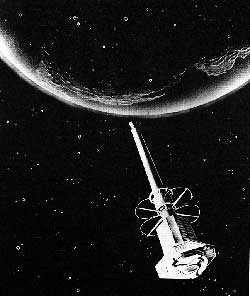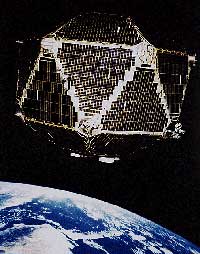Gamma-ray Astronomy
Gamma-ray Astronomy
Long before experiments could detect gamma rays emitted by cosmic sources, scientists had known that the Universe should be producing such high energy photons. Hard work by several brilliant scientists had shown us that a number of different processes which were occurring in the Universe would result in gamma-ray emission. These processes included cosmic ray interactions with interstellar gas, supernova explosions, and interactions of energetic electrons with magnetic fields. In the 1960s, we finally developed the ability to detect these emissions, and we have been looking at them ever since.

Artist's concept of Explorer 11 in orbit. (Credit: NASA)
Gamma-rays coming from space are mostly absorbed by the Earth's atmosphere. So gamma-ray astronomy could not develop until it was possible to get our detectors above all or most of the atmosphere, using balloons or spacecraft. The first gamma-ray telescope carried into orbit, on the Explorer 11 satellite in 1961, picked up fewer than 100 cosmic gamma-ray photons. These appeared to come from all directions in the Universe, implying some sort of uniform "gamma-ray background". Such a background would be expected from the interaction of cosmic rays (very energetic charged particles in space) with gas found between the stars.
The first detection of significant gamma-ray emission from our galaxy was made in 1967 by the the gamma-ray detector aboard the OSO-3 satellite. In fact, OSO-3 also detected the first gamma-rays from outside our galaxy! All told, it detected 621 cosmic gamma rays. However, the field of gamma-ray astronomy took great leaps forward with the SAS-2 (1972) and the COS-B (1975-1982) satellites. These two satellites provided an exciting view into the high-energy universe, sometimes called the "violent" universe, because the type of events in space that produce gamma rays tend to be explosions and high-speed collisions. The data from the satellites confirmed the earlier findings of the gamma-ray background, produced the first detailed map of the sky at gamma-ray wavelengths, and detected a number of point sources, where the sources of radiation were very concentrated and emanated from a small area. However, the poor resolution of the instruments made it impossible to identify most of these point sources with individual stars or stellar systems.

The Vela 5B satellite in low-Earth orbit. (Credit: LANL)
Perhaps the most spectacular discovery in gamma-ray astronomy came in the late 1960s and early 1970s from a collection of defense satellites that were put into orbit for a reason completely unrelated to astronomy research. Detectors on board the Vela satellite series were designed to detect flashes of gamma rays from nuclear bomb blasts. They began to record bursts of gamma rays, not from the vicinity of Earth, but from deep space. These gamma-ray bursts (GRBs) can last for fractions of a second to minutes, popping off like cosmic flashbulbs from unexpected directions, flickering, and then fading after briefly dominating the gamma-ray sky. Studied for over 25 years with instruments on board a variety of satellites and space probes, including Soviet Venera spacecraft and the Pioneer Venus Orbiter, the sources of these enigmatic high-energy flashes for a while remained a mystery. In one of the most intense debates in modern astrophysics, some scientists claimed that the bursts originate in a halo of neutron stars which surround our Galaxy while others argued that their origins are far beyond the Galaxy, at cosmological distances. This was settled in 1996 when the BeppoSax satellite and the Hubble Space Telescope pinpointed the location of a gamma-ray burst in a distant galaxy.
In 1977, NASA announced plans to build a "great observatory" for gamma-ray astronomy. The Compton Gamma-Ray Observatory (CGRO) was designed to take advantage of the major advances in detector technology during the 1980s, and was launched in 1991. The satellite carried four major experiments which greatly improved the spatial and temporal resolution of gamma-ray observations. The CGRO provided large amounts of data which have been used to improve our understanding of the high-energy processes in our Universe. CGRO was de-orbited in June 2000 as a result of the failure of one of its stabilizing gyroscopes.

Artist's rendering of the Swift satellite. (Credit: Spectrum Astro)
In November 2004, NASA launched the Swift satellite. Its primary mission is to detect and locate GRBs as quickly as possible, report the position of the burst, then follow up with other observations of that location in the X-ray, UV and visual spectra. On April 13, 2010, NASA's Swift satellite recorded its 500th GRB.
To continue the study of the universe in the gamma-ray spectrum, Swift currently operates in conjunction with the Fermi Gamma-Ray Space Telescope, launched in 2008. Fermi, originally called GLAST (Gamma-ray Large Area Space Telescope), also studies GRBs, as well as blazars, neutron stars, gamma-ray background radiation, supernova remnants, dark matter and more.
What can gamma rays tell us about the cosmos? Gamma-rays are the most energetic form of electromagnetic radiation, with over 10,000 times more energy than visible light photons. If you could see gamma-rays, the night sky would look strange and unfamiliar. The familiar sights of constantly shining stars and galaxies would be replaced by something ever-changing. Your gamma-ray vision would peer into the hearts of solar flares, supernovae, neutron stars, black holes, and active galaxies. Gamma-ray astronomy presents unique opportunities to explore these exotic objects. By exploring the universe at these high energies, scientists can search for new physics, testing theories and performing experiments which are not possible in earth-bound laboratories. Watch the video below to see a few of the highlights of Fermi's first five years in orbit for an idea of the types of objects gamma-ray astronomers study.
Fermi at five years, a compilation video summarizing the wide range of science from the first five years of the Fermi Gamma-ray Telescope. (Credit: NASA)
Updated: September 2013

